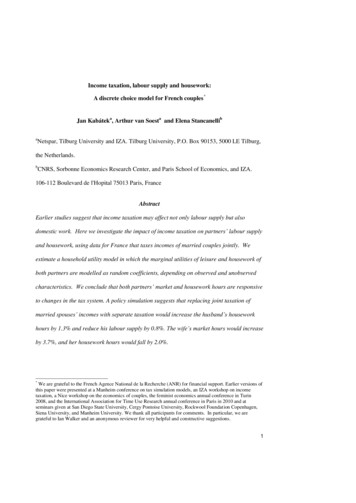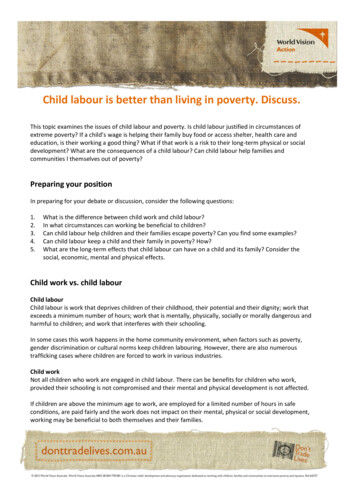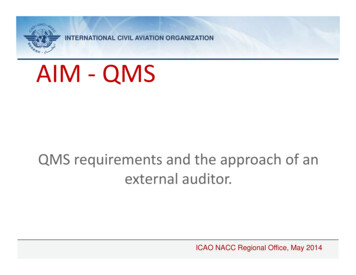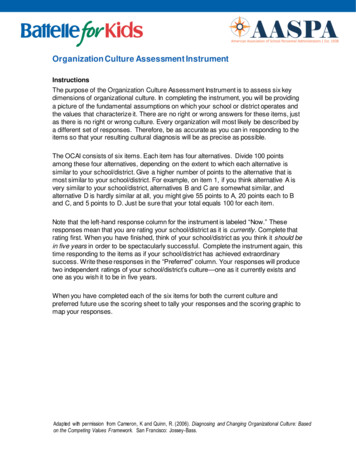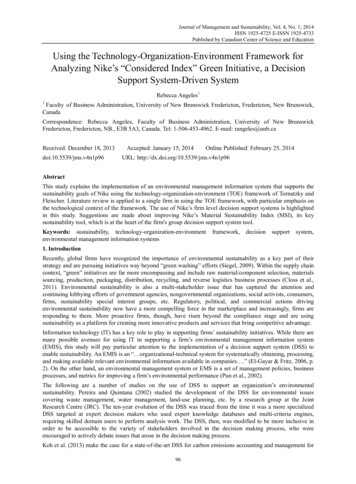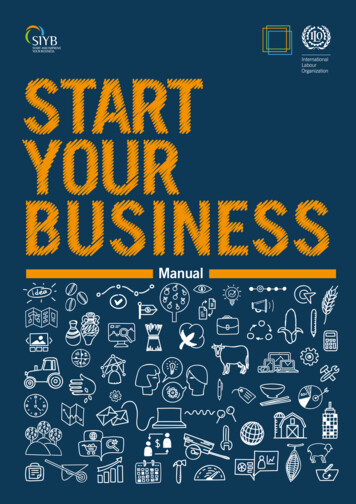
Transcription
Manual
Startyour businessMANUALInternational Labour Office
Copyright International Labour Organization 2015First published 2015This is an open access work distributed under the Creative Commons Attribution-ShareAlike 3.0 IGO 3.0/igo). Users can re-use, share, adapt and build upon theoriginal work, even for commercial purposes, as detailed in the License. Any new works that use the originalcontent must carry the same CC-BY-SA licence. The ILO must be clearly credited as the owner of the originalwork. The use of the emblem of the ILO is not permitted in connection with users’ work.Translations – In case of a translation of this work, the following disclaimer must be added along with theattribution: This translation was not created by the International Labour Office (ILO) and should not be consideredan official ILO translation. The ILO is not responsible for the content or accuracy of this translation.Adaptations – In case of an adaptation of this work, the following disclaimer must be added along with theattribution: This is an adaptation of an original work by the International Labour Office (ILO). Responsibility forthe views and opinions expressed in the adaptation rests solely with the author or authors of the adaptation andare not endorsed by the ILO. Adaptations not endorsed by the SME Unit of the ILO cannot use the SIYB brand nameand logo.All queries on rights and licensing should be addressed to ILO Publications (Rights and Licensing), CH-1211Geneva 22, Switzerland, or by email to rights@ilo.org.International Labour OfficeStart your business: manual / International Labour Office, Enterprises Department. - Geneva: ILO, 2015ISBN: 9789221287612; 9789221287629 (web pdf ); 9789221287636 (set)International Labour Office Enterprises Dept.enterprise creation / corporate planning / small enterprise03.04.5ILO Cataloguing in Publication DataThe designations employed in ILO publications, which are in conformity with United Nations practice, andthe presentation of material therein do not imply the expression of any opinion whatsoever on the part of theInternational Labour Office concerning the legal status of any country, area or territory or of its authorities, orconcerning the delimitation of its frontiers.The responsibility for opinions expressed in signed articles, studies and other contributions rests solely withtheir authors, and publication does not constitute an endorsement by the International Labour Office of theopinions expressed in them.Reference to names of firms and commercial products and processes does not imply their endorsement bythe International Labour Office, and any failure to mention a particular firm, commercial product or processis not a sign of disapproval.ILO publications and digital products can be obtained through major booksellers and digital distributionplatforms, or ordered directly from ilo@turpin-distribution.com. For more information, visit our website:www.ilo.org/publns or contact ilopubs@ilo.org.Printed in Switzerland
About the Start and Improve Your Business (SIYB) ProgrammeThe Start and Improve Your Business (SIYB) programme is a management-training programme developedby the International Labour Organization (ILO) with a focus on starting and improving small businessesas a strategy for creating more and better employment for women and men, particularly in emergingeconomies. With an estimated outreach in over 100 countries, it is one of the world’s largest programmesin this field.The programme has four inter-related packages - Generate Your Business Idea (GYB), Start Your Business(SYB), Improve Your Business (IYB) and Expand Your Business (EYB).The ILO implements the programme using a three-tier structure comprising Master Trainers, Trainers andthe end beneficiaries – potential and existing entrepreneurs. The Master Trainers licensed by the ILO areresponsible for developing the capacity of the Trainers to effectively conduct SIYB training. Thereafter, theTrainers train entrepreneurs in SIYB packages. The ILO plays a critical role in identifying and disseminatingbest practices, carrying out trainings, monitoring activities, performing quality control and providingtechnical advice on the implementation of the SIYB programme.About Start Your Business (SYB)Start Your Business (SYB) is a training programme for potential entrepreneurs who have a feasible businessidea for their own small enterprise. The training helps in developing a detailed business plan and toactually get started. The training also provides an opportunity to test the required entrepreneurial skillsand the business plan in a simulated and safe environment.The SYB training course usually delivered in five days using the SYB manual and business plan booklet.The training uses an active, problem-centred learning approach which builds on what the potentialentrepreneur already knows. It challenges the entrepreneur by introducing new market dynamicsthrough, for example, short cases and graphic illustrations.
Authors and acknowledgementsThe SYB manual is a result of a collective effort and reflects the experience and knowledge gathered byimplementing the programme for nearly three decades. In particular, the contributions of SIYB Master Trainersand Trainers who have tested, designed and implemented the programme in different countries over the yearshave been invaluable. There are many colleagues from the network of SIYB practitioners, consulting firmsand in the ILO, whose experience, support and constructive suggestions made the publication of this trainingmanual possible.This manual is based on the materials originally developed in 1996 by the ILO SIYB Regional Project Officein Harare, Zimbabwe. The authors of the original version are Geoffrey Meredith, Douglas Stevenson, HakanJarskog, Barbara Murray and Ulf Kallstig. The original manual was subsequently revised by the ILO YouthEntrepreneurship Facility (YEF), whereby it was written and reviewed by Milena Mileman and SibongileSibanda. Short contributions and other valuable materials and ideas used in the YEF versions were provided byJulius Mutio, Marek Harsdoff, Milan ‘Divecha, Namsifu Nyagabona, Mike Oneko, Dorothy Katantazi and StephenKyalibulha.The author team of the 2015 version, which revised the existing text and wrote new chapters to include recentthinking in enterprise development and related fields comprises Phan Minh Tue and Pranati Mehtha. Stylisticand language editing were carried out by Steve Raymond.Many thanks are due to SIYB senior Master Trainers Dissou Zomahoun, Gemunu Wijesena, Sibongile Sibandaand Walter Verhoeve for the review of the draft manuscript and suggestions based on their training experience.A special thanks to the ILO colleagues- Marek Harsdorff from the Green Jobs Programme of the EnterprisesDepartment; Jurgen Menze and Esteban Tromel from the Gender, Equality and Diversity Branch; Julia Faldtfrom the HIV and AIDS and the World of Work Branch, Kristen Sobeck and Patrick Belser from the InclusiveLabour Markets, Labour Relations and Working Conditions Branch, for their contribution to the content ofthe manual. Short contributions, advice and assistance on integrating linkages to finance in the manual werereceived from Cheryl Frankiewicz and Severine Deboos (Technical Expert in the Social Finance Unit of ILO’sEnterprises Department).The internal layout and illustrations were carried out by Le Nguyen Sang and the cover design was developedby Maurizio Costanza.The review efforts and technical contributions of the SIYB Global Coordination Team members who providedinvaluable support to the development and finalization of the manual is greatly appreciated: Merten Sievers(Specialist – Value Chain Development and Business Development Services), Eva Majurin (SIYB GlobalCoordinator) and Thokozile Newman.
ContentsINTRODUCTIONi1. What is this manual about?i2. Who should read this manual?i3. Objectives of this manuali4. How to use this manual?iiPART I - ASSESS YOUR READINESS TO START A BUSINESS011. Assess your entrepreneurial abilities012. How to strengthen your entrepreneurial abilities?05Summary07PART II - THE Business Plan091. Why is Business Plan important?092. Content of the Business Plan103. Where to find information for your Business Plan?11Summary12PART III - REINFORCE YOUR business idea13Summary16PART IV - THE Marketing Plan171. Conduct market research172. Make a Marketing Plan222.1 Product222.2 Price262.3 Place302.4 Promotion312.5 People342.6 Process352.7 Physical Evidence36
3. Sales estimation37Summary39PART V - STAFF411. What staff do you need?412. Staff costs42Summary44PART VI - ORgANIZATION AND MANAgEMENT451. Form of business451.1 The different forms of business461.2 How to select the right form of business?472. Legal responsibilities and insurance51Summary54PART VII - BUYINg FOR YOUR BUSINESS551. Equipment552. Raw materials563. Finished goods56Summary58PART VIII - gREENINg YOUR BUSINESS591. Your business and natural resources592. Increase efficiency and profits: reduce, reuse, recycle603. Classifying the waste60Summary61PART IX - COSTINg YOUR Goods and services631. What are costs?632. Costing for a manufacturer or service operator643. Costing for a retailer or wholesaler73Summary79
PART X - FINANCIAL PLANNINg811. What is financial planning?812. Make a Profit Plan812.1 Sales Plan812.2 Cost Plan832.3 Profit Plan843. Make a Cash Flow Plan86Summary90PART XI - REQUIRED START-UP CAPITAL911. What capital investments do you need?912. What working capital do you need?93Summary96PART XII - TYPES AND SOURCES OF START-UP CAPITAL971. Owner’s equity972. Loans97Summary100PART XIII - STARTINg THE BUSINESS1011. Are you ready to start your business?1012. Start or not?1033. Do you need more information to complete your Business Plan?1034. Presenting and defending your Business Plan1035. Action Plan for starting your business104
INTRODUCTION1.What is this manual about?There are many things to think about when you start a new business. This manual will help you to organizeyour thoughts and to develop a plan for your business idea. After you have gone through the manual, you willbe able to assess whether or not your business idea has the potential to evolve into a profitable enterprise andwhether you should go ahead or you should reconsider your original concept. If you then decide to develop youridea into a business, this manual will teach you how to start.2.Who should read this manual?Start Your Business (SYB) is a manual for people who have a practical business idea and want to start a newbusiness. It introduces the proper steps for starting a business and creating a Business Plan for the proposedventure.3.Objectives of this manualWhen you have completed this manual, you should be able to: 4.Describe the content of a Business PlanConsolidate your business ideaTranslate your business idea into a completed Business PlanAssess your readiness for starting a businessHow to use this manual?The SYB manual is accompanied with a SYB Business Plan booklet. The manual explains the steps that youneed to follow in order to start a business. The Business Plan booklet is to be completed as you go through themanual.INTRODUCTION INTRODUCTION i
In this manual you will find: Stories of businesses: Compare these examples with your future business and use them to improveyour plan to start the business. Activities: Practical exercises in the middle of each part that help you to proactively think about theconcepts and how to apply them to your future business. Summary: This is provided at the end of each part. Use it to review the key points. Action Plan: Fill in and use the Action Plan near the end of the manual. These will help you to put yournew knowledge into practice. Important notes: Each of these notes has important information. Use this information to the best ofyour ability. You can find these notes in the middle of different parts of the manual.Several icons are used within the manual to help guide your study. Examples of the icons and their meaningsare listed below:When you see this icon, you have activities to do or questions to answer.When you see this icon, it signifies that the information in this part is extremely important.When you see this icon, you will know you have just completed one part and the important ideas thatwere presented are being summarized here.When you see this icon, it tells you where to find more information or what to do.ii Start Your Business
PART I ASSESS YOUR READINESSTO START A BUSINESSBefore you decide to start your own business, you should assess whether or not you are ready to run abusiness of your own. The success of your business will depend on your entrepreneurial abilities (personalcharacteristics, situation and skills) and your commitment to the environment and community. You shouldconsider which of your characteristics needs improvement and then try to change your situation and skills.1.Assess your entrepreneurial abilitiesThe following activity will help you find out if you have the abilities to successfully run your business. Be honestin your assessment.ACTIVITY 1To help you decide if you have what it takes to be in business, think about each of the following factors.Decide if each of these factors is a strength or an area in which you need to improve. For example, if youhave knowledge in business management, this is a strong point. But if you lack such knowledge andyou plan to hire someone else to manage your business and make decisions, then this may be an areaof improvement.PART I Assess your readiness to start a business 01
PERSONAL CHARACTERISTICS AND YOUR SITUATIONCommitmentFor your business to be a reality and to succeed, you must becommitted. Commitment means that you are willing to put yourbusiness before almost everything else. Do you want to be in businessfor a long time? Can you spend most of your time and efforts onyour business?MotivationYour business is more likely to succeed if you are very motivated to tryyour business idea, create wealth and make your money work for you.Do you know clearly why you want to have your own business?Taking risksThere is no absolutely safe business idea. You always run the risk offailure. Are you prepared to take risks? Are you willing to risk yourmoney to invest in your business?Making decisionsYou are in charge of your business, which means that you have tomake decisions that may lead to either success or failure. Importantdecisions cannot be postponed or passed on to someone else. Canyou make difficult decisions by yourself?Ability to handle stressEntrepreneurs are subject to a lot of stress. Stress may be the resultof either difficult decisions that must be made, dealing withstakeholders in the business or working long hours. Are you excitedabout your business prospects? Do you derive a great deal of enjoymentfrom your work?Problem solvingRunning your own business requires that you are able to solve problems.Do you have the ability to solve the root cause of problems in creativeways?Goal orientationOne feature that differentiates an entrepreneur from an employeeis the ability to develop and achieve goals. You should be able toenvision where your business is headed and to see the biggerpicture, rather than just focusing on minor details. Have you drawna vision and set a goal for your business?02 Start Your BusinessAREAS OFSTRENGTHAREAS THATNEEDIMPROVEMENT
Social supportRunning your business will take a lot of time and effort. It is importantto have adequate support from family, friends and other businesspeople. Do you have a social network of people and organizationsthat will support the realization of your dream?Financial situationAccess to financial resources to start your business is important.Have you set money aside to get your business started? If youneed additional funds, do you have family or friends who might bewilling and able to lend you money, to use their assets to guaranteeyour loan with a financial institution? Do you have a savings orcredit history with a financial institution that offers loans to newbusinesses?SKILLSAREAS OFSTRENGTHAREAS THATNEEDIMPROVEMENTTechnical skillsTechnical skills are the practical abilities you need for your businessidea to result in goods produced or services provided. For example,if you want to start a cell phone service and repair shop, you need toknow how to repair cell phones. Do you have technical skills that arenecessary for your business?Business management skillsBusiness management skills are the abilities to run your businessefficiently. Do you have skills in marketing, costing, record keeping,people motivation, etc.?Knowledge of your line of businessThe more you know about your line of business, the more you willavoid making costly mistakes. Do you have a detailed knowledge ofthe specific type of business that you want to start?Negotiation skillsNegotiation skill is the ability to communicate with others withoutoffending anyone. When you negotiate, you not only think aboutwhat is in your favour, but you must be aware of things that are inthe other person’s favour also. Can you get what you want from anegotiation in a way that both parties can benefit?PART I Assess your readiness to start a business 03
ENVIRONMENTAL AND COMMUNITY CONCERNSAREAS OFSTRENGTHAREAS THATNEEDIMPROVEMENTNumber ofareas ofstrengthNumber ofareas that needimprovement.Your business and the environmentAs an entrepreneur, you need to know the environmental issuesaffecting your line of business. Do you know how to sustain the naturalcapital or resources on which your business depends?Commitment to your communityYour business needs to be community friendly. Entrepreneurs areimportant members of the community and you need to have acommitment to the advancement of the community as a whole. Do youhave a good relationship with the community?Count the number of areas of strength and the number of areas thatneed improvement and write the total here.Look at the assessment areas above and decide which ones that need improvement or growth are critical foryour business success. Note the number of needed improvements below:CRITICAL AREAS NEEDING IMPROVEMENT AND GROWTH04 Start Your Business
2.How to strengthen your entrepreneurial abilities?There are many ways to alter your characteristics, improve your business skills and situation and also addressthe necessary environmental and community concerns. Here are some suggestions on how to strengthen yourentrepreneurial abilities:Read: Research on books about businessesthat can be found in most libraries; also readbusiness related articles on the internet, innewspapers and magazines.Attend training: Find and attend universityor privately funded training programmes inbusiness management, technical skills ormotivation and entrepreneurship.Learn from successful business people:You should be able to find successful businesspeople who will talk to you about theirbusinesses. If they allow you to visit theirbusiness locations, observe them as theywork and learn from them. If possible, work asan apprentice in a related successful business.Seek help from others: Talk about theareas that need improvement with yourfriends and family. You could also join abusiness association and discuss the issueswith other members in the association.PART I Assess your readiness to start a business 05
You might want to think about finding a partner who complements your abilities, instead of going into businessentirely on your own. A partner might also be able to bring financial resources, collateral or relationships withfinancial service providers that could be helpful if your business ever needed a loan.There are a number of successful business people who did not have much experience or practice in abusiness situation before starting their businesses. What is important is to be aware of the areas that needimprovement and develop a plan of action to deal with these before they negatively affect your business.ACTIVITY 2Complete the following Action Plan to help you think about ways to improve your entrepreneurial abilities.action planMy characteristics and situationWhat will I do to strengthen them?My skillsWhat will I do to strengthen them?Environmental concernsWhat will I do to address them?Community concernsWhat will I do to address them?06 Start Your Business
“Include these issues in your capacity development plan in theAction Plan at the end of this manual.Now do you feel comfortable about starting your own business?Yes“NoIf you are comfortable about starting your own business and think that you will be able to work on the areasthat need improvement, you are ready to start planning. The following parts will guide you in the process ofcreating an Action Plan to actually start the business.If you have answered “No” to the question above, think more about what you can do to improve your abilities asan entrepreneur. Remember, not everyone can run a business. If you still do not feel comfortable about startinga business, maybe you should work for somebody else instead.SUMMARYIn Part I you have learned the following: Before you decide to start your own business, you should assess whether or not you are ready to runa business. The success of your business will depend on your personal characteristics, situation, skills and howwell you address environmental and community concerns. The more entrepreneurial characteristics,situation and skills you have, the more likely it is that your business will succeed. You can make yourself aware of the characteristics that need improvement, change your situation,address environmental and community concerns and acquire the skills needed for the business.PART I Assess your readiness to start a business 07
08 Start Your Business
PART II THE Business Plan1.Why is Business Plan important?Putting your ideas and information together is called making a Business Plan.You need to prepare the Business Plan because it helps you to: Decide if you should start your business or not. Starting a business will change your lifecompletely. Therefore, you need to make sure that you make the right decision. The Business Plan willhelp you to judge whether or not starting a business is the right decision. Organize your ideas so that you will see how to start and run your business in the best possible way.The Business Plan follows a standard sequence of relevant topics which will help you to visualize theroad ahead. Present your Business Plan to investors or to a lending institution, such as a bank or a microfinanceinstitution, to obtain a loan. By preparing the Business Plan yourself, you will be able to answer mostof the questions they may ask.The accompanying booklet contains the outline of the Business Plan that you will complete for yourbusiness idea.“It is important to continually take the time to find new and betterinformation. Feel free to go back and change the Business Planat any time as you work through the manual.“PART II The business plan 09
2.Content of the Business PlanA Business Plan should cover all the important aspects to be considered before starting a business.Main parts of theBusiness PlanPurposesExecutive SummaryThe executive summary is an outline of your business idea. You will, therefore,need to complete all the other parts of the plan before doing the executive summary.It must be clear and organized, because it is the first impression one gets of yourbusiness idea.The Business IdeaAll business plans are based on an idea. Part III helps you to think about the conceptof your business idea so that you can put your idea in writing at the beginning ofyour Business Plan.The Marketing PlanMarketing is everything you do to find customers and satisfy their needswhile making profit. Part IV helps you to think about and create yourMarketing Plan.StaffYou need to think about staffing your business. Part V helps you to think about allthe jobs that need to be accomplished in your new business and to decide whowill do them.Organization andManagementPart VI explains the different types of businesses and helps you to decide whichtype suits you best. Part VI also helps you to understand the legal requirementsof your business and shows you how insurance can provide a form of financialsecurity against risks.Buying forYour BusinessWhatever business you are in, you need to buy before you make or sell yourproducts. Part VII will advise you on what you should consider when you buy tostart your business.Greening YourBusinessDifferent businesses depend upon and use natural resources in their productionprocesses in different ways. Part VIII introduces the three “Rs” strategy: Reduce,Reuse and Recycle to help your business have a positive impact on the environmentand be more profitable.CostingTo be able to set your prices and make a financial plan, you need to calculate thecost of your products. Part IX shows you how to do costing.Financial PlanningAll businesses need to plan for the future. Part X helps you plan how to make aprofit and how to handle the cash flow for your new business.Required Start-upCapitalTo start a business, you need money for equipment, materials, rent, wages, etc.Part XI helps you to calculate how much capital you need to start your business.Sources of Start-upCapitalWhen you know how much start-up capital you need, you have to figureout how to source that amount. Part XII explains how you can get start-upcapital from both the owner’s equity and loans.10 Start Your Business
3.Where to find information for your Business Plan?You can find some of the information on your own and use your own experience to do many of the estimatesand calculations. But some information may be difficult to find and some estimates and calculations may bedifficult to make. It is helpful to have someone with experience in the business to assist you or to review yourBusiness Plan.The following list suggests possible sources of assistance: Business development services providers that offer different services, such as management training,access to market information, access to financial information and technical training. These could begovernment departments, consultants, specialist projects or other non-governmental organizations. Industry specific associations that offer information on legislation, taxes, standards and otherindustry specific developments that might have an effect on your new business. Accountants, lawyers and business consultants can assist with some parts of your Business Plan. Financial institutions such as banks, cooperative societies or microfinance institutions sometimesgive assistance to entrepreneurs who apply for a loan. International organizations with special projects designed to assist entrepreneurs could help youaccess information. Yellow pages are where you can find addresses of organizations handling things like businessregistration, taxes and financial requirements for small businesses. On the internet, you can find most of the information that you will need to complete your plan.PART II The business plan 11
SUMMARYIn Part II you have learned that: Putting your ideas and information together is called making a Business Plan. A Business Plan helps you to:-- Decide if you should start your business or not.-- Organize your ideas so that you will know how to start and run your business in the bestpossible way.-- Present your Business Plan to investors or to a lending institution, such as a bank or a microfinance institution, to obtain a loan. A Business Plan should cover all the important aspects to be considered before starting a business.It is a guide for you to follow so that you do not overlook anything when preparing to open yournew business. You may find information for your Business Plan from the following sources:-- Business development services providers-- Industry specific associations-- Accountants, lawyers and business consultants-- Financial institutions-- International organizations-- Yellow pages-- Internet12 Start Your Business
PART III REINFORCE YOUR business ideaWhen you see a business opportunity, you need to develop your thoughts into a business idea. A business ideais a short and precise description of the basic operation of the business. Your business idea will tell you: What good or service will your business sell? Your business idea should be based on a particular skillthat you have. Maybe you have experience with or have been trained in a specific line of business. Who is your business going to sell to? Will you only try to sell to a specific type of customer or toeveryone in an area? It is important to be clear about who you intend to sell to. How is your business going to sell its goods or services? You can sell in many different ways. Amanufacturer can, for example, sell either directly to customers or to retailers. Which need will your business fulfil? Your business idea should always have the customer and thecustomer’s needs in mind. It is important to find out what customers want when you work out yourbusiness idea. What impact will your business have on the community and the natural environment? Your attitudeand people’s view on your business will determine your success. If you exploit labour and damage thenatural environment (waste generation, water wastage, deforestation) people might avoid your business.ACTIVITY 3To make sure your business idea is concrete and feasible, answer following questions:1. What good or service will your business sell?.2. Who will buy your good or servic
idea into a business, this manual will teach you how to start. Start Your Business (SYB) is a manual for people who have a practical business idea and want to start a new business. It introduces the proper steps for starting a business and creating a Business Plan for the proposed venture. Wh



